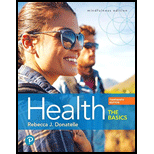
EBK HEALTH
13th Edition
ISBN: 9780134814506
Author: Donatelle
Publisher: YUZU
expand_more
expand_more
format_list_bulleted
Concept explainers
Question
Chapter 3, Problem 2PQ
Summary Introduction
To identify: The stage of stress does the fight-or-fight response arise
Introduction:
Stress refers to physical and mental response of the body to any kind of threat or demand. Stress can be caused by both positive and negative experiences. Exhaustion stage, resistance stage, and alarm stage are the three phases of general adaptation syndrome (stress).
Expert Solution & Answer
Want to see the full answer?
Check out a sample textbook solution
Chapter 3 Solutions
EBK HEALTH
Ch. 3 - Prob. 1WDYTCh. 3 - Prob. 2WDYTCh. 3 - Prob. 3WDYTCh. 3 - Even though Andre experienced stress when he...Ch. 3 - Prob. 2PQCh. 3 - Prob. 3PQCh. 3 - Prob. 4PQCh. 3 - Prob. 5PQCh. 3 - Prob. 6PQCh. 3 - Prob. 7PQ
Ch. 3 - Prob. 8PQCh. 3 - Prob. 9PQCh. 3 - After 5 years of 70-hour work weeks, Tom decided...Ch. 3 - Define stress. What are some examples of...Ch. 3 - Describe the alarm, resistance and exhaustion...Ch. 3 - What are some of the health risks that result from...Ch. 3 - Prob. 4TAICh. 3 - Prob. 5TAICh. 3 - Prob. 6TAICh. 3 - Prob. 7TAI
Knowledge Booster
Learn more about
Need a deep-dive on the concept behind this application? Look no further. Learn more about this topic, health-nutrition and related others by exploring similar questions and additional content below.Similar questions
- What is the function of the hormone erythropoietin? a. stimulates production of red blood cells b. stimulates muscle growth c. causes the fight-or-flight response d. causes testosterone productionarrow_forwardDesign a test (or series of tests) to support or refute this hypothesis: People who have no family history of high blood pressure (hypertension) but who eat a diet high in salt are more likely to develop high blood pressure than people with a similar family history but whose diet is much lower in salt.arrow_forwardWatch this video (http://openstaxcollege.org/l/fightflight) to learn more about adrenaline and the fightor-flight response. When someone is said to have a rush of adrenaline, the image of bungee jumpers or skydivers usually comes to mind. But adrenaline, also known as epinephrine, is an important chemical in coordinating the bodys fight-or-flight response. In this video, you look inside the physiology of the fight-or-flight response, as envisioned for a firefighter. His bodys reaction is the result of the sympathetic division of the autonomic nervous system causing system-wide changes as it prepares for extreme responses. What two changes does adrenaline bring about to help the skeletal muscle response?arrow_forward
Recommended textbooks for you
 Comprehensive Medical Assisting: Administrative a...NursingISBN:9781305964792Author:Wilburta Q. Lindh, Carol D. Tamparo, Barbara M. Dahl, Julie Morris, Cindy CorreaPublisher:Cengage Learning
Comprehensive Medical Assisting: Administrative a...NursingISBN:9781305964792Author:Wilburta Q. Lindh, Carol D. Tamparo, Barbara M. Dahl, Julie Morris, Cindy CorreaPublisher:Cengage Learning Concepts of BiologyBiologyISBN:9781938168116Author:Samantha Fowler, Rebecca Roush, James WisePublisher:OpenStax College
Concepts of BiologyBiologyISBN:9781938168116Author:Samantha Fowler, Rebecca Roush, James WisePublisher:OpenStax College- Basic Clinical Lab Competencies for Respiratory C...NursingISBN:9781285244662Author:WhitePublisher:Cengage

Comprehensive Medical Assisting: Administrative a...
Nursing
ISBN:9781305964792
Author:Wilburta Q. Lindh, Carol D. Tamparo, Barbara M. Dahl, Julie Morris, Cindy Correa
Publisher:Cengage Learning

Concepts of Biology
Biology
ISBN:9781938168116
Author:Samantha Fowler, Rebecca Roush, James Wise
Publisher:OpenStax College




Basic Clinical Lab Competencies for Respiratory C...
Nursing
ISBN:9781285244662
Author:White
Publisher:Cengage